Digital Maturity of Administration Entities in a State-Led Food Certification System Using the Example of Baden-Württemberg
Abstract
1. Introduction
- What is the current level of digital maturity among private and semi-private stakeholders within the state-led certification system in Baden-Württemberg, as measured by the DMA?
- What measures can be implemented by the public entity in the state-led certification system to close the digital maturity gaps in these organisations?
- Is the European DMA framework an appropriate method for evaluating digital maturity and guiding policy measures within a state-led certification system?
2. Literature Review
2.1. The Certification System
2.2. Digital Maturity
3. Materials and Methods
3.1. Overview
3.2. Survey Design
3.3. European Digital Maturity Assessment
3.4. Data Analysis
4. Results and Discussion
4.1. Demographics of Respondents
4.2. Total Digital Maturity Scores
4.3. Dimension Scores
- (1)
- D4: Data Management (except in the administration body, where D3 is highest);
- (2)
- D3: Human-Centric Digitalisation;
- (3)
- D1: Digital Strategy;
- (4)
- D6: Green Digitalisation;
- (5)
- D2: Digital Readiness;
- (6)
- D5: Automation and Intelligence.
4.4. Suitability of the Method
5. Conclusions and Outlook
Supplementary Materials
Author Contributions
Funding
Institutional Review Board Statement
Informed Consent Statement
Data Availability Statement
Acknowledgments
Conflicts of Interest
Abbreviations
| AI | Artificial Intelligence |
| AR | Augmented Reality |
| BIM | Building Information Modelling |
| BIOZBW | Organic Label Baden-Württemberg |
| CAD | Computer-Aided Design |
| CAM | Computer-Aided Manufacturing |
| CEADS | Common European Agricultural Data Space |
| DG CNECT | Directorate General for Communications Networks, Content and Technology |
| CRM | Customer Relationship Management |
| DMA | Digital Maturity Assessment |
| EDIH | European Digital Innovation Hub |
| EFS | Enterprise Feedback Suite |
| ERP | Enterprise Resource Planning |
| EU | European Union |
| GDPR | General Data Protection Regulation |
| ICT | Information and Communication Technology |
| IQR | Interquartile Range |
| JRC | European Joint Research Centre |
| MLR | Ministry for Rural Affairs and Consumer Protection Baden-Württemberg |
| NLP | Natural Language Processing |
| PO | Producer Organisation |
| PSO | Public Sector Organisation |
| QZBW | Quality Label Baden-Württemberg |
| SME | Small and Medium Enterprises |
| VAT | Value Added Tax |
| VR | Virtual Reality |
References
- Albuquerque, T.G.; Oliveira, M.B.P.; Costa, H.S. 25 Years of European Union (EU) Quality Schemes for Agricultural Products and Foodstuffs across EU Member States. J. Sci. Food Agric. 2018, 98, 2475–2489. [Google Scholar] [CrossRef] [PubMed]
- Krystallis, A.; Chrysochou, P.; Perrea, T.; Tzagarakis, N. A Retrospective View on Designation of Origin Labeled Foods in Europe. J. Int. Food Agribus. Mark. 2017, 29, 217–233. [Google Scholar] [CrossRef]
- Nes, K.; Antonioli, F.; Ciaian, P. Trends in Sustainability Claims and Labels for Newly Introduced Food Products across Selected European Countries. Agribusiness 2024, 40, 371–390. [Google Scholar] [CrossRef]
- Ion, R.; Daniela, P.; Sterie, C.; Tarhini, M. Food Certification: A Bibliometric Analysis. Int. J. Sustain. Econ. Manag. 2022, 11, 1–8. [Google Scholar] [CrossRef]
- Latino, M.E.; Corallo, A.; Menegoli, M.; Nuzzo, B. An Integrative Conceptual Framework of Food Certifications: Systematic Review, Research Agenda, and Macromarketing Implications. J. Macromark. 2022, 42, 71–99. [Google Scholar] [CrossRef]
- Barbancho-Maya, G.; López-Toro, A.A. Determinants of Quality and Food Safety Systems Adoption in the Agri-Food Sector. Br. Food J. 2022, 124, 219–236. [Google Scholar] [CrossRef]
- Ciliberti, S.; Frascarelli, A.; Polenzani, B.; Brunori, G.; Martino, G. Digitalisation Strategies in the Agri-Food System: The Case of PDO Parmigiano Reggiano. Agric. Syst. 2024, 218, 103996. [Google Scholar] [CrossRef]
- Tokkozhina, U.; Martins, A.L.; Ferreira, J.C.; Casaca, A. Traceable Distribution of Fish Products: State of the Art of Blockchain Technology Applications to Fish Supply Chains. In Lecture Notes of the Institute for Computer Sciences, Social Informatics and Telecommunications Engineering; Springer Nature: Cham, Switzerland, 2023; pp. 89–100. ISBN 978-3-031-30854-3. [Google Scholar]
- Patro, P.K.; Jayaraman, R.; Salah, K.; Yaqoob, I. Blockchain-Based Traceability for the Fishery Supply Chain. IEEE Access 2022, 10, 81134–81154. [Google Scholar] [CrossRef]
- Ramachandran, G.S.; Deane, F.; Malik, S.; Dorri, A.; Jurdak, R. Towards Assisted Autonomy for Supply Chain Compliance Management. In Proceedings of the 2021 Third IEEE International Conference on Trust, Privacy and Security in Intelligent Systems and Applications (TPS-ISA), virtual, 13–15 December 2021; IEEE: New York, NY, USA, 2021; pp. 321–330. [Google Scholar]
- Ancin, M.; Pindado, E.; Sanchez, M. New Trends in the Global Digital Transformation Process of the Agri-Food Sector: An Exploratory Study Based on Twitter. SSRN Electron. J. 2022, 203, 103520. [Google Scholar] [CrossRef]
- Hassoun, A.; Marvin, H.J.P.; Bouzembrak, Y.; Barba, F.J.; Castagnini, J.M.; Pallarés, N.; Rabail, R.; Aadil, R.M.; Bangar, S.P.; Bhat, R.; et al. Digital Transformation in the Agri-Food Industry: Recent Applications and the Role of the COVID-19 Pandemic. Front. Sustain. Food Syst. 2023, 7, 1217813. [Google Scholar] [CrossRef]
- Kovács, T.; Botos, S.; Felföldi, J. What Does Digital Transformation Do in Agriculture? A Systematic Literature Review of Agri-Food Sector’s Digitalisation. J. Agric. Inform. 2024, 14. [Google Scholar] [CrossRef]
- Evans, E.W.; Lacey, J.; Taylor, H.R. Identifying Support Mechanisms to Overcome Barriers to Food Safety Scheme Certification in the Food and Drink Manufacturing Industry in Wales, UK. Int. J. Environ. Health Res. 2020, 32, 377–392. [Google Scholar] [CrossRef] [PubMed]
- Evans, E.W.; Taylor, H.R. Understanding the Barriers to Food Safety Scheme Certification in the Food and Drink Manufacturing Industry in Wales, UK. Int. J. Environ. Health Res. 2019, 31, 225–236. [Google Scholar] [CrossRef] [PubMed]
- Khan, S.; Khan, M.I.; Haleem, A. Evaluation of Barriers in the Adoption of Halal Certification: A Fuzzy DEMATEL Approach. J. Model. Manag. 2019, 14, 153–174. [Google Scholar] [CrossRef]
- Aydel, O.A. Assessing the Digital Maturity of an Enterprise as the First Step to Digital Transformation. Bus. Strateg. 2021, 9, 369–370. [Google Scholar] [CrossRef]
- Remané, G.; Hanelt, A.; Wiesböck, F.; Kolbe, L. Digital Maturity in Traditional Industries—An Exploratory Analysis. In Proceedings of the 25th European Conference on Information Systems, Guimarães, Portugal, 5–10 June 2017. [Google Scholar]
- Herzog, M.; Wilkens, U.; Bülow, F.; Hohagen, S.; Langholf, V.; Öztürk, E.; Kuhlenkötter, B. Enhancing Digital Transformation in SMEs with a Multi-Stakeholder Approach—Implications from a Socio-Technical Systems Perspective. In Digitization of the Work Environment for Sustainable Production; GITO: Berlin, Germany, 2022; pp. 17–35. ISBN 978-3-95545-407-4. [Google Scholar]
- Hohagen, S.; Wilkens, U. How to measure digital maturity in agriculture? Conceptual outline, instrument development and measurement results from German farms. Int. Food Agribus. Manag. Rev. 2025. online ahead of print. [Google Scholar] [CrossRef]
- Frau, M.; Moi, L.; Cabiddu, F. Digital Transformation Through the Lens of Digital Data Handling: An E Xploratory Analysis of Agri-Food SMEs. J. Small Bus. Strategy 2022, 32, 84–97. [Google Scholar] [CrossRef]
- Bakare, O.A.; Achumie, G.O.; Okeke, N.I. The Impact of Administrative Efficiency on SME Growth and Sustainability. Open Access Res. J. Multidiscip. Stud. 2024, 8, 126–138. [Google Scholar] [CrossRef]
- Jirwanto, H. The Effect of Financial Digitalization on Savings and Cost Reduction i n MSME Entrepreneurs in Medan City. J. Ekon. Dan Bisnis Digit. 2024, 3, 101–116. [Google Scholar] [CrossRef]
- Cai, F.Z.; Huang, S.Y.; Kessler, T.S.; Fottner, F.J. A Case Study: Digitalization of Business Processes of SMEs with Low-Co de Method. IFAC-PapersOnLine 2022, 55, 1840–1845. [Google Scholar] [CrossRef]
- Pfister, P.; Lehmann, C. Returns on Digitisation in SMEs—A Systematic Literature Review. J. Small Bus. Entrep. 2021, 35, 574–598. [Google Scholar] [CrossRef]
- Bundesministerium für Wirtschaft und Klimaschutz. Digitalisierung der Wirtschaft in Deutschland Digitalisierungsindex; Bundesministerium für Wirtschaft und Klimaschutz: Berlin, Germany, 2024. [Google Scholar]
- Kalpaka, A. Digital Maturity Assessment (DMA) Framework and Questionnaires for SMEs/PSOs: A Guidance Document for EDIHs; European Comission: Brussels, Belgium, 2023. [Google Scholar]
- Hafseld, K.H.J.; Hussein, B.; Rauzy, A.B. An Attempt to Understand Complexity in a Government Digital Transformation Project. Int. J. Inf. Syst. Proj. Manag. 2021, 9, 70–91. [Google Scholar] [CrossRef]
- Ministry of Nutrition. Rural Areas and Consumer Protection of Baden-Württemberg Regionale Landwirtschaft. Available online: https://mlr.baden-wuerttemberg.de/de/unsere-themen/landwirtschaft/regionale-landwirtschaft (accessed on 16 April 2025).
- Ministry of Nutrition. Rural Areas, and Consumer Protection of Baden-Württemberg Programmbestimmungen QZBW Stand 2025. Available online: https://mbw.imageplant.de/media/category/143 (accessed on 6 March 2025).
- Petrović, Z.; Milićević, D.; Nastasijević, I.; Đorđević, V.; Trbović, D.; Velebit, B. The Role of Food Quality Assurance and Product Certification Systems on Marketing Aspects. IOP Conf. Ser. Earth Environ. Sci. 2017, 85, 012011. [Google Scholar] [CrossRef]
- Wang, S. 29. Korean Food Law Administration and Governance in Food Certification System. In European Institute for Food Law Series; Wageningen Academic Publishers: Wageningen, The Netherlands, 2019; pp. 441–453. ISBN 978-90-8686-334-1. [Google Scholar]
- Albersmeier, F.; Schulze, H.; Spiller, A. System Dynamics in Food Quality Certifications: Development of an Audit Integrity System. Int. J. Food Syst. Dyn. 2010, 1, 69–80. [Google Scholar] [CrossRef]
- Landesanstalt für Landwirtschaft, Ernährung und Ländlichen Raum Schwäbisch Gmünd GQS Hof-Check. Available online: https://lel.landwirtschaft-bw.de/,Lde/Startseite/Unsere+Themen/GQS+Hof-Check (accessed on 28 April 2025).
- McFadden, J.; Casalini, F.; Griffin, T.; Antón, J. The Digitalisation of Agriculture: A Literature Review and Emerging Policy Issues; CABI Digital Library: Wallingford, CT, USA, 2022. [Google Scholar] [CrossRef]
- Anghel, B.; Bunel, S.; Bijnens, G.; Botelho, V.; Falck, E.; Labhard, V.; Lamo, A.; Röhe, O.; Schroth, J.; Sellner, R.; et al. Digitalisation and Productivity. SSRN Electron. J. 2024. [Google Scholar] [CrossRef]
- Qian, C.; Murphy, S.I.; Orsi, R.H.; Wiedmann, M. How Can AI Help Improve Food Safety? Annu. Rev. Food Sci. Technol. 2023, 14, 517–538. [Google Scholar] [CrossRef]
- Kumar, I.; Rawat, J.; Mohd, N.; Husain, S. Opportunities of Artificial Intelligence and Machine Learning in the Food Industry. J. Food Qual. 2021, 2021, 4535567. [Google Scholar] [CrossRef]
- Kollia, I.; Stevenson, J.; Kollias, S. AI-Enabled Efficient and Safe Food Supply Chain. Electronics 2021, 10, 1223. [Google Scholar] [CrossRef]
- Siddique Ibrahim, S.P.; Karthikeyan, L.; Bhoomika, P.; Tejaswi, K.; Khande, L.S.; Vemishetti, N.S. Automating Nutritional Claim Verification: The Role of OCR and Machine Learning in Enhancing Food Label Transparency. In Proceedings of the 2024 International Conference on IoT Based Control Networks and Intell igent Systems (ICICNIS), Bengaluru, India, 17–18 December 2024; IEEE: New York, NY, USA, 2024; pp. 1164–1171. [Google Scholar]
- Tajkarimi, M. Food Safety and Quality Data Management Using Artificial Intelligence. Food Prot. Trends 2020, 40, 464. [Google Scholar] [CrossRef]
- Sunmola, F.; Baryannis, G.; Tan, A.; Co, K.; Papadakis, E. Holistic Framework for Blockchain-Based Halal Compliance in Supply Chains Enabled by Artificial Intelligence. Systems 2025, 13, 21. [Google Scholar] [CrossRef]
- Mu, W.; Kleter, G.A.; Bouzembrak, Y.; Dupouy, E.; Frewer, L.J.; Radwan Al Natour, F.N.; Marvin, H.J.P. Making Food Systems More Resilient to Food Safety Risks by Including a Rtificial Intelligence, Big Data, and Internet of Things into Food Safety Early Warning and Emerging Risk Identification Tools. Compr. Rev. Food Sci. Food Saf. 2024, 23, e13296. [Google Scholar] [CrossRef]
- Papageorgopoulos, N.; Vergeti, D.; Politi, E.; Ntalaperas, D.; Papageorgiou, X.S.; Karvounis, M.; Stoitsis, G.; Rakic, B.; Kotlar, M.; Petrov, S.; et al. An Agri-Food Data Platform for Food Safety and Certification. In Proceedings of the 2022 International Conference on Computational Science and Computational Intelligence (CSCI), Las Vegas, NV, USA, 14–16 December 2022; IEEE: New York, NY, USA, 2022; pp. 634–639. [Google Scholar]
- Ladu, L.; Koch, C.; Asna Ashari, P.; Blind, K.; Castka, P. Technology Adoption and Digital Maturity in the Conformity Assessment Industry: Empirical Evidence from an International Study. Technol. Soc. 2024, 77, 102564. [Google Scholar] [CrossRef]
- Reed, H.G.; Dailey, N. Decentralized Approaches Disrupt Multi-Stakeholder Activities. In Proceedings of the Disruptive Technologies in Information Sciences VII, Orlando, FL, USA, 1–3 May 2023; Wysocki, B.T., Holt, J., Blowers, M., Eds.; SPIE: Bellingham, WA, USA, 2023; p. 9. [Google Scholar]
- Hrustek, L.; Tomičić Furjan, M.; Varga, F.; Džidić, A.; Van Loenen, B.; Šalamon, D. Towards Digital Innovation: Stakeholder Interactions in Agricultural Data Ecosystem in Croatia. Interdiscip. Descr. Complex Syst. 2022, 19, 491–499. [Google Scholar] [CrossRef]
- Hrustek, L.; Šalamon, D.; Tomičić Furjan, M. Maturity of Agriculture Open Data Ecosystem in Croatia—Challenges and Opportunities. IPSI Trans. Internet Res. 2024, 20, 29–46. [Google Scholar] [CrossRef]
- Nummiluikki, J.; Mustapaa, T.; Hietala, K.; Viitala, R. Benefits of Network Effects and Interoperability for the Digital Calibration Certificate Management. In Proceedings of the 2021 IEEE International Workshop on Metrology for Industry 4.0 and IoT, MetroInd 4.0 and IoT 2021-Proceedings, Roma, Italy, 7–9 June 2021; IEEE: New York, NY, USA, 2021; pp. 352–357. [Google Scholar]
- Profiroiu, C.M.; Negoiță, C.I.; Costea, A.V. Digitalization of Public Administration in EU Member States in Times of Crisis: The Contributions of the National Recovery and Resilience Plans. Int. Rev. Adm. Sci. 2024, 90, 336–352. [Google Scholar] [CrossRef]
- Idrus, S.H.; Sumartono, E.; Wartono, W.; Suharto, S.; Syahriar, I. Harnessing Digital Transformation for Improved Public Service Delivery: Lessons from Global Administrative Practices. Join J. Soc. Sci. 2024, 1, 257–269. [Google Scholar] [CrossRef]
- Imanbekova, A.M.; Fyliuk, Н.М.; Stavbunik, E.A. Some Aspects of Digitalization on Public Administration. Buketov Bus. Rev. 2024, 11329, 45–54. [Google Scholar] [CrossRef]
- Organisation for Economic Cooperation and Development. OECD Survey on Drivers of Trust in Public Institutions—2024 Results: Building Trust in a Complex Policy Environment; OECD: Paris, France, 2024; ISBN 978-92-64-33830-2. [Google Scholar]
- Zorić, N.; Marić, R.; Jurković-Marić, T.; Vukmirović, G. The Importance of Digitalization for the Sustainability of the Food Supply Chain. Sustainability 2023, 15, 3462. [Google Scholar] [CrossRef]
- European Parliament Council. Communication from the Commission to the European Parliament, the Council, the European Economic and Social Committee and the Committee of the Regions 2030 Digital Compass: The European Way for the Digital Decade; European Parliament Council: Strasbourg, France, 2021. [Google Scholar]
- Kurilova, A.; Antipov, D. Methodological Approaches to Assessing the Level of Digitalization of Countries and Regions. IOP Conf. Ser. Mater. Sci. Eng. 2020, 986, 012021. [Google Scholar] [CrossRef]
- Brodny, J.; Tutak, M. Assessing the Level of Digitalization and Robotization in the Enterprises of the European Union Member States. PLoS ONE 2021, 16, e0254993. [Google Scholar] [CrossRef]
- Katz, R.L.; Koutroumpis, P. Measuring Digitization: A Growth and Welfare Multiplier. Technovation 2013, 33, 314–319. [Google Scholar] [CrossRef]
- Rossmann, A. Digital Maturity: Conceptualization and Measurement Model. In Proceedings of the Thirty Ninth International Conference on Information Systems, San Francisco, CA, USA, 13–16 December 2018. [Google Scholar]
- Ustaoğlu, N. A Maturity Model for Digital Transformation. 2019. [Google Scholar]
- Kane, G.; Palmer, D.; Phillips, A.N.; Kiron, D.; Buckley, N. Achieving Digital Maturity. MIT Sloan Manag. Rev. 2017, 59, 1–31. [Google Scholar]
- Aslanova, I.V.; Kulichkina, A.I. Digital Maturity: Definition and Model. Adv. Econ. Bus. Manag. Res. 2020, 138, 443–447. [Google Scholar] [CrossRef]
- Thordsen, T.; Murawski, M.; Bick, M.; Hattingh, M.; Matthee, M.; Smuts, H.; Pappas, I.; Dwivedi, Y.K.; Mäntymäki, M. How to Measure Digitalization? A Critical Evaluation of Digital Maturity Models. Responsible Des. Implement. Use Inf. Commun. Technol. 2020, 358–369. [Google Scholar] [CrossRef]
- Carrijo, P.; Alturas, B.; Pedrosa, I. Analysis of Digital Transformation Maturity Models. In Proceedings of the 2021 16th Iberian Conference on Information Systems and Technologies (CISTI), Chaves, Portugal, 23–26 June 2021; IEEE: New York, NY, USA, 2021; pp. 1–6. [Google Scholar]
- European Parliament Council. Decision—2022/2481 of the European Parliament and Council of 14 December 2022—Establishing the Digital Decade Policy Programme 2030; European Parliament Council: Strasbourg, France, 2022. [Google Scholar]
- Creswell, J.W.; Creswell, J.D. Research Design: Qualitative, Quantitative, and Mixed Methods Approaches; SAGE Publications: Thousand Oaks, CA, USA, 2017; ISBN 978-1-5063-8669-0. [Google Scholar]
- Marketing Gesellschaft Baden-Württemberg Gemeinschaftsmarketing Baden-Württemberg—Downloadcenter. Available online: https://mbw.imageplant.de (accessed on 6 March 2025).
- Tivian XI GmbH. Enterprise Feedback Suite Survey Version 23.1. Tivian XI GmbH. Available online: https://www.unipark.com/en/survey-software/ (accessed on 23 March 2025).
- Microsoft Corporation. Microsoft Excel Version 2504. Microsoft Corporation. Available online: https://www.microsoft.com/de-de/microsoft-365/excel (accessed on 23 March 2025).
- Wu, M.-J.; Zhao, K.; Fils-Aime, F. Response Rates of Online Surveys in Published Research: A Meta-Analysis. Comput. Hum. Behav. Rep. 2022, 7, 100206. [Google Scholar] [CrossRef]
- L’Ecuyer, K.M.; Subramaniam, D.S.; Swope, C.; Lach, H.W. An Integrative Review of Response Rates in Nursing Research Utilizing Online Surveys. Nurs. Res. 2023, 72, 471–480. [Google Scholar] [CrossRef]
- Baruch, Y.; Holtom, B. Survey Response Rate Levels and Trends in Organizational Research. Hum. Relat. 2008, 61, 1139–1160. [Google Scholar] [CrossRef]
- Holtom, B.; Baruch, Y.; Aguinis, H.; Ballinger, G.A. Survey Response Rates: Trends and a Validity Assessment Framework. Hum. Relat. 2022, 75, 1560–1584. [Google Scholar] [CrossRef]
- Saleh, A.; Bista, K. Examining Factors Impacting Online Survey Response Rates in Educationa l Research: Perceptions of Graduate Students. J. Multidiscip. Eval. 2017, 13, 63–74. [Google Scholar] [CrossRef]
- Blumenberg, C.; Barros, A.J.D. Response Rate Differences between Web and Alternative Data Collection Methods for Public Health Research: A Systematic Review of the Literat Ure. Int. J. Public Health 2018, 63, 765–773. [Google Scholar] [CrossRef]
- Sundberg, L.; Gidlund, K.L.; Olsson, L. Towards Industry 4.0? Digital Maturity of the Manufacturing Industry in a Swedish Region. In Proceedings of the 2019 IEEE International Conference on Industrial Engineering and Engineering Management (IEEM), Macao, 15–18 December 2019; IEEE: New York, NY, USA, 2019; pp. 731–735. [Google Scholar]
- Debrenti, A.S. Measuring Digital Readiness in Food Industry. J. EcoAgriTourism 2020, 16, 11–20. [Google Scholar]
- Subramaniyam, M.; Halim-Lim, S.A.; Mohamad, S.F.B.; Priyono, A. Digital Supply Chain in the Food Industry: Critical Success Factors an d Barriers. In Proceedings of the 2021 IEEE International Conference on Industrial Engineering and Engineering Management (IEEM), Singapore, 13–16 December 2021; IEEE: New York, NY, USA, 2021; pp. 404–410. [Google Scholar]
- Kaszás, N.; Ernszt, I.; Jakab, B. The Emergence of Organizational and Human Factors in Digital Maturity Models. Management 2023, 28, 123–135. [Google Scholar] [CrossRef]
- Schneider, M.; Hellweg, T.; Menzefricke, J.S. Identification of Human and Organizational Key Design Factors for Digital Maturity—A Fuzzy-Set Qualitative Comparative Analysis. Proc. Des. Soc. 2022, 2, 791–800. [Google Scholar] [CrossRef]
- Bedetti, I.; Annosi, M.C.; Bucci, G.; Bentivoglio, D.; Dolfsma, W.; Finco, A. The Role of Managers or Owners of SMEs in Driving the Digitalization Process in the Agri-Food Sector. In How is Digitalization Affecting Agri-Food? Routledge: London, UK, 2020; pp. 37–48. ISBN 978-0-429-20370-1. [Google Scholar]
- Dehghani, M.; Popova, A.; Gheitanchi, S. Factors Impacting Digital Transformations of the Food Industry by Adoption of Blockchain Technology. J. Bus. Ind. Mark. 2021, 37, 1818–1834. [Google Scholar] [CrossRef]
- Chourad, R.; Beeraladinni, D.; Vasudeva Naik, K.; Jamdar, R.; Joshi, A.; Deshmanya, J.B. Economic Impacts of Digital Transformation in Agricultural Extension Services. Int. J. Agric. Ext. Soc. Dev. 2024, 7, 197–201. [Google Scholar] [CrossRef]
- Finger, R. Digital Innovations for Sustainable and Resilient Agricultural Systems. Eur. Rev. Agric. Econ. 2023, 50, 1277–1309. [Google Scholar] [CrossRef]
- Kosior, K. Digital Transformation in the Agri-Food Sector—Opportunities and Challenges. Ann. Pol. Assoc. Agric. Agribus. Econ Omists 2018, 98–104. [Google Scholar] [CrossRef]
- Marie-Agnès, J. Digital Opportunities for Trade in the Agriculture and Food Sectors; Organisation for Economic Co-Operation and Development (OECD): Paris, France, 2019. [Google Scholar]
- Chamochumbi, D.; Ciambotti, M.; Palazzi, F.; Sgrò, F. The Digital Transformation Process in the Agri-Food Sector: A Case Study. Manag. Control Spec. Issue 2 2022, 2022, 43–70. [Google Scholar] [CrossRef]
- Polunina, N.Y.; Zaitseva, E.A.; Chernysheva, I.I. On the Value of Digital Transformation for the Agro-Food Sector. Sci. Rev. Theory Pract. 2024, 14, 1042–1052. [Google Scholar] [CrossRef]
- Scuderi, A.; Via, L.; Timpanaro, G.; Sturiale, L. Current and Future Opportunities of Digital Transformation in the Agri Food Sector. In Proceedings of the 9th International Conference on Information and Communication Technologies in Agriculture, Food & Environment (HAICTA 2020), Thessaloniki, Greece, 24–27 September 2020. [Google Scholar]
- Aartsen, W.; Peeters, P.; Wagers, S.; Williams-Jones, B. Getting Digital Assets from Public-Private Partnership Research Projects through “The Valley of Death,” and Making Them Sustainable. Front. Med. 2018, 5, 65. [Google Scholar] [CrossRef]
- European Commission. The Data Spaces Support Centre|Shaping Europe’s Digital Future. Available online: https://digital-strategy.ec.europa.eu/en/news/data-spaces-support-centre (accessed on 25 February 2025).
- Falcão, R.; Matar, R.; Rauch, B.; Elberzhager, F.; Koch, M. A Reference Architecture for Enabling Interoperability and Data Sovereignty in the Agricultural Data Space. Information 2023, 14, 197. [Google Scholar] [CrossRef]
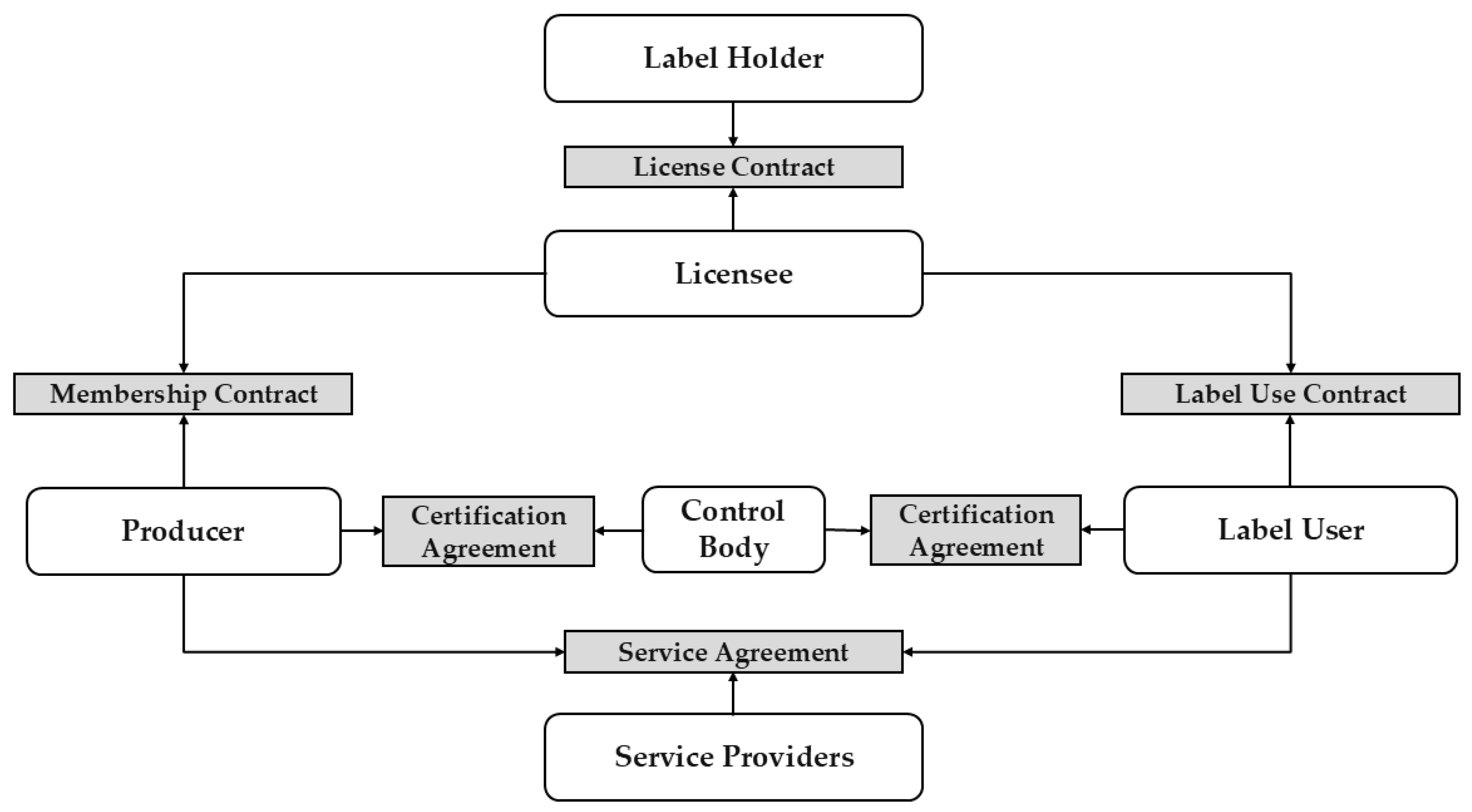


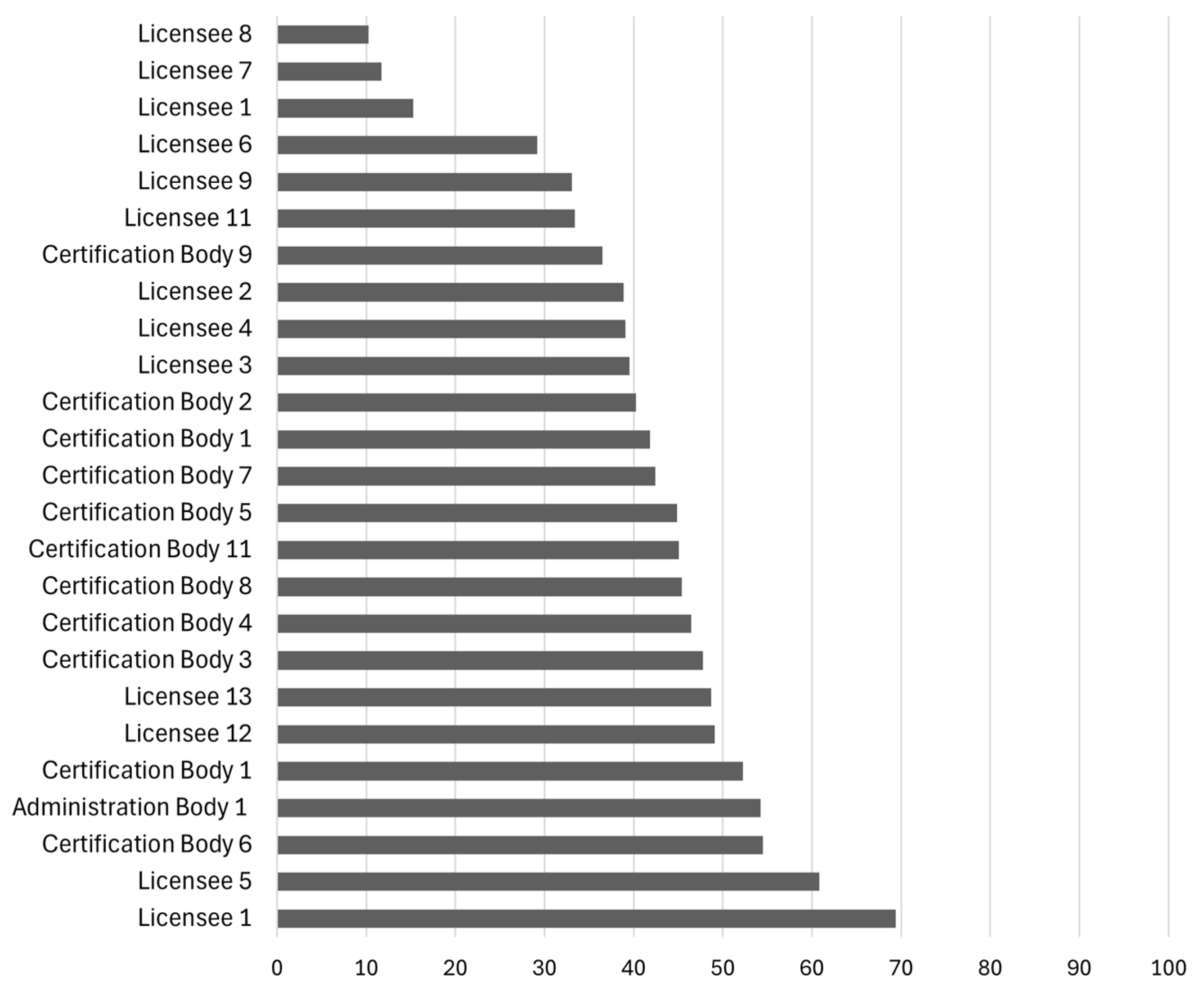

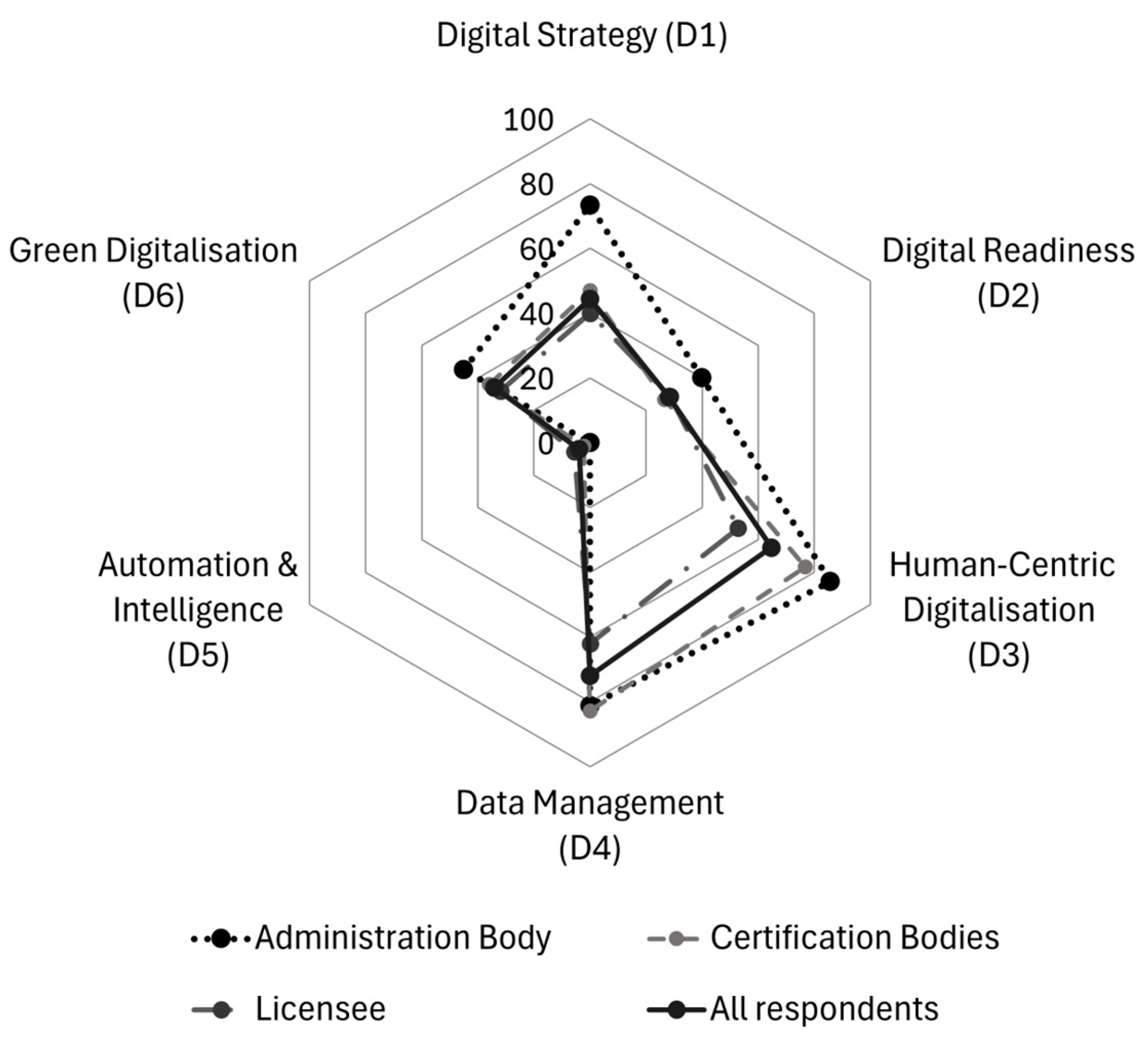
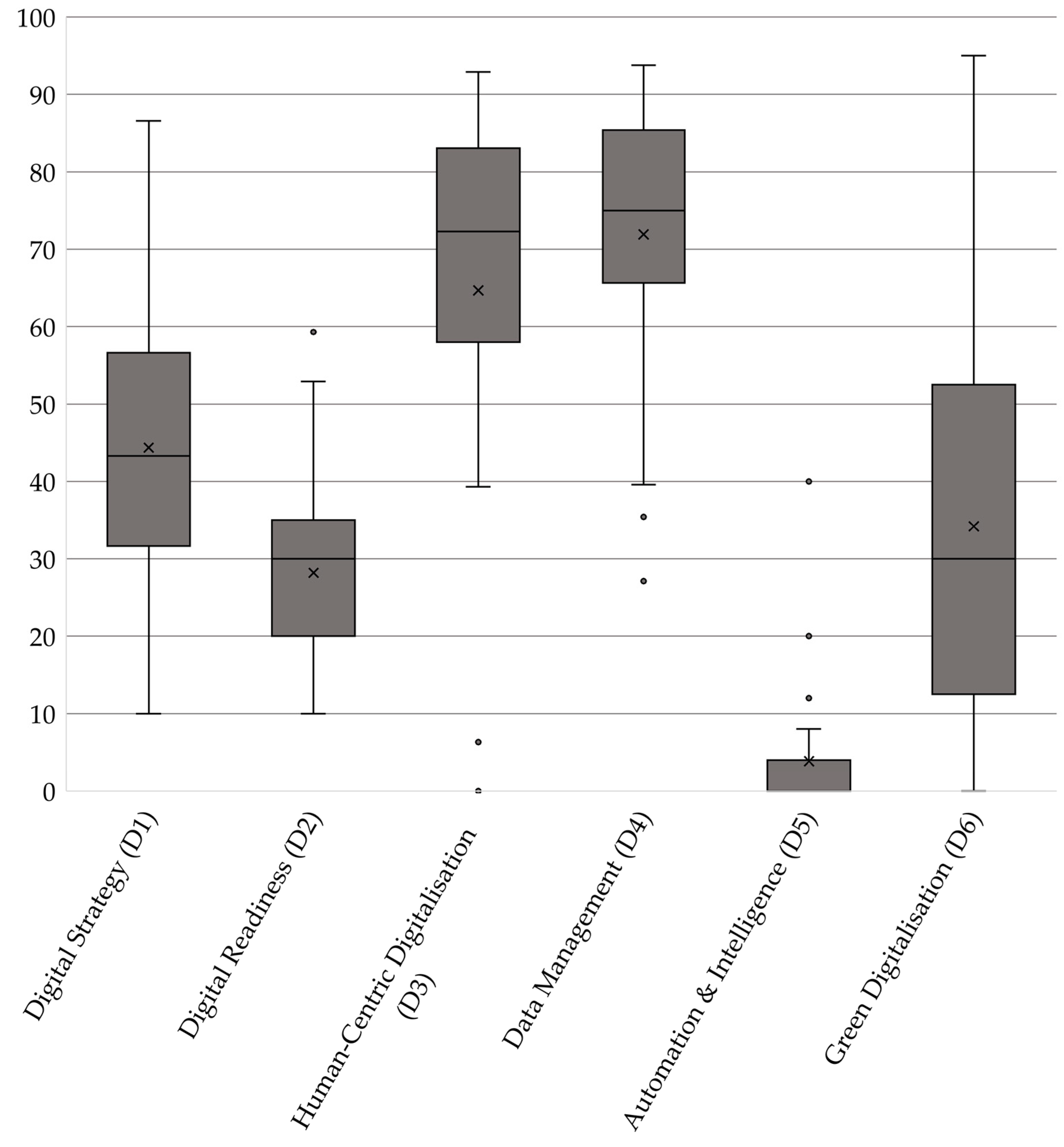
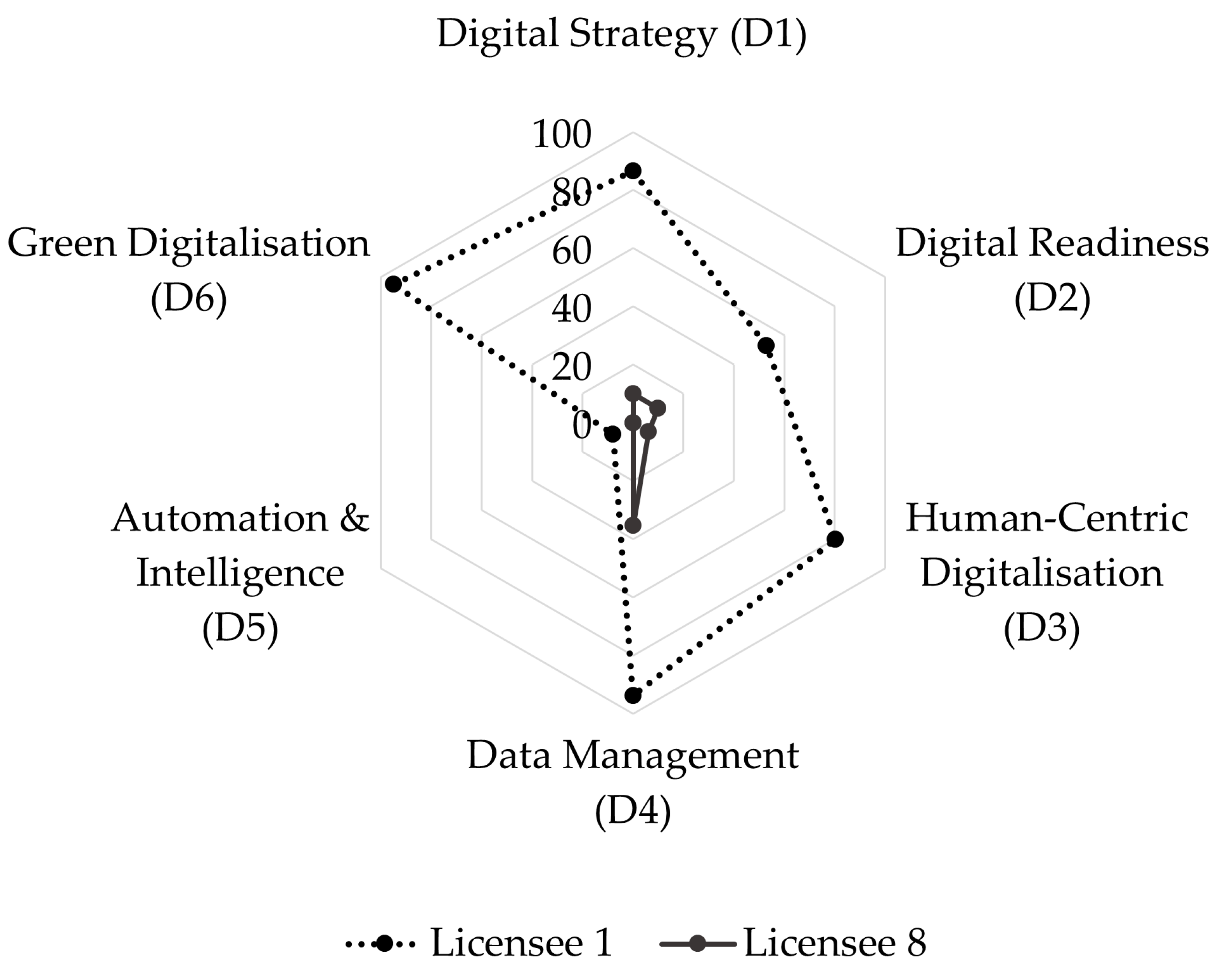
| Dimension | Question |
|---|---|
| Digital Business Strategy | In which business areas has your enterprise already invested in digitalisation and in which does it plan to invest in the future? |
| In which ways is your enterprise prepared for further digitalisation? | |
| Digital Readiness | Which digital technologies and solutions are already used by your enterprise? |
| Which advanced digital technologies are already used by your enterprise? | |
| Human-Centric Digitalisation | What does your enterprise do to reskill and upskill its staff for digitalisation? |
| When adopting new digital solutions, how does your enterprise engage and empower its staff? | |
| Data Management | How is your enterprise data managed (stored, organised, accessed, and exploited)? |
| Is your enterprise’s data sufficiently secured? | |
| Automation and AI | Which technologies and business applications is your enterprise already using? |
| Green Digitalisation | How does your enterprise make use of digital technologies to contribute to environmental sustainability? |
| Is your enterprise taking into account environmental impacts in its digital choices and practices? |
| Section | Key Takeaway |
|---|---|
| Demographics | In total, 58% of participation from 43 invited certification stakeholders highlights engagement but risk of bias, with the majority of respondents being small-scale licensees. |
| Overall Maturity | Moderate maturity with wide gaps between most and least digitalised organisations. |
| D4: Data Management | Data Management is the strongest dimension with robust digital storage policies, but gaps exist in external data analytics, self-service insights, and continuity planning. |
| D3: Human-Centric Digitalisation | Human-Centric Digitalisation ranks second with the strong training and workforce involvement. Internships and dedicated support services remain rare despite change management. |
| D1: Digital Strategy | Cybersecurity is a focus, but strategic planning in logistics, procurement, and marketing lags. |
| D6: Green Digitalisation | Paperless admin is common, but formal sustainability frameworks are mostly missing. |
| D2: Digital Readiness | Digital Readiness is low with basic websites and portals; advanced tools (IoT, e-commerce, e-gov) are scarce. |
| D5: Automation and AI | Almost no automation or AI in daily use—just a handful of small tests. |
| Suitability of the DMA Method | Top and bottom performers show huge contrasts, so “one-size-fits-all” will not work. |
| The framework covers all angles but includes some overly futuristic or irrelevant items. |
Disclaimer/Publisher’s Note: The statements, opinions and data contained in all publications are solely those of the individual author(s) and contributor(s) and not of MDPI and/or the editor(s). MDPI and/or the editor(s) disclaim responsibility for any injury to people or property resulting from any ideas, methods, instructions or products referred to in the content. |
© 2025 by the authors. Licensee MDPI, Basel, Switzerland. This article is an open access article distributed under the terms and conditions of the Creative Commons Attribution (CC BY) license (https://creativecommons.org/licenses/by/4.0/).
Share and Cite
Francksen, S.; Ghaziani, S.; Bahrs, E. Digital Maturity of Administration Entities in a State-Led Food Certification System Using the Example of Baden-Württemberg. Foods 2025, 14, 1870. https://doi.org/10.3390/foods14111870
Francksen S, Ghaziani S, Bahrs E. Digital Maturity of Administration Entities in a State-Led Food Certification System Using the Example of Baden-Württemberg. Foods. 2025; 14(11):1870. https://doi.org/10.3390/foods14111870
Chicago/Turabian StyleFrancksen, Sabrina, Shahin Ghaziani, and Enno Bahrs. 2025. "Digital Maturity of Administration Entities in a State-Led Food Certification System Using the Example of Baden-Württemberg" Foods 14, no. 11: 1870. https://doi.org/10.3390/foods14111870
APA StyleFrancksen, S., Ghaziani, S., & Bahrs, E. (2025). Digital Maturity of Administration Entities in a State-Led Food Certification System Using the Example of Baden-Württemberg. Foods, 14(11), 1870. https://doi.org/10.3390/foods14111870








